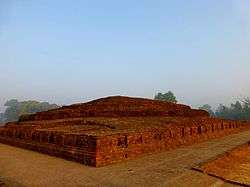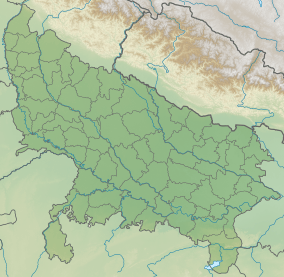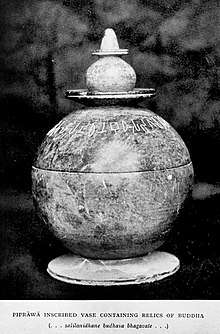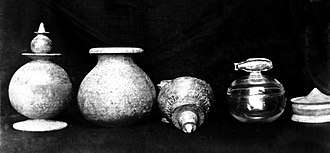Piprahwa
Piprahwa is a village near Birdpur in Siddharthnagar district of the Indian state of Uttar Pradesh. Kalanamak rice, a scented and spicy variety of rice is grown in this area.[1] It lies in the heart of the historical Buddha's homeland and is 12 miles from the world heritage site of Lumbini that is believed to be the place of Gautama Buddha's birth.
Piprahawa Piprahava | |
|---|---|
village | |
 Stupa at Piprahwa | |
 Piprahawa Location in Uttar Pradesh, India  Piprahawa Piprahawa (Uttar Pradesh) | |
| Coordinates: 27.443000°N 83.127800°E | |
| Country | |
| State | Uttar Pradesh |
| District | Siddharthnagar |
| Languages | |
| • Official | Hindi |
| Time zone | UTC+05:30 (IST) |
Piprahwa is best known for its archaeological site and excavations that suggest that it may have been the burial place of the portion of the Buddha's ashes that were given to his own Shakya clan. A large stupa and the ruins of several monasteries as well as a museum are located within the site. Ancient residential complexes and shrines were uncovered at the adjacent mound of Ganwaria.
Excavation by William Claxton Peppe
A buried stupa was discovered by William Claxton Peppe, a British colonial engineer and landowner of an estate at Piprahwa in January 1898. Following the severe famine that decimated Northern India in 1897, Peppe led a team in excavating a large earthen mound on his land. Having cleared away scrub and jungle, they set to work building a deep trench through the mound. After digging through 18 feet of solid brickwork, they came to a large stone coffer which contained five small vases containing bone fragments, ashes, and jewels.[2] On one of the vases was a Brahmi script which was translated by Georg Bühler, a leading European epigraphist of the time, to mean:

Sukiti-bhatinaṃ sabhaginikanam sa-puta-dalanam iyaṃ salila-nidhane Budhasa bhagavate sakiyanam[3]
"This relic-shrine of divine Buddha (is the donation) of the Sakya-Sukiti brothers, associated with their sisters, sons, and wives,[4]
This inscription implied that the bone fragments were part of the remains of Gautama Buddha, the founder of Buddhism.[5] Throughout the following decade or so, epigraphists debated the precise meaning of the inscription. Vincent Smith, William Hoey, Thomas Rhys Davids, and Emile Senart all translated the inscription to confirm that these were relics of the Buddha.[6][7]
In 1905, John Fleet, a former epigraphist of the Government of India, published a translation that agreed with this interpretation.[8] However, on assuming the role of Secretary of the Royal Asiatic Society from Thomas Rhys Davids, Fleet proposed a different reading:[9][10]
"This is a deposit of relics of the brethen of Sukiti, kinsmen of Buddha the Blessed One, with their sisters, their children and wives."[3]

This interpretation was firmly rejected by his contemporaries. Following such criticism Fleet wrote: "I now abandon my opinion".[11] Epigraphists of the time subscribed instead to the translation by Auguste Barth:
"This receptacle of relics of the blessed Buddha of the Śākyas (is the pious gift) of the brothers of Sukīrti, jointly with their sisters, with their sons and their wives."[12]
Over a hundred years later, in the 2013 documentary, Bones of the Buddha, epigraphist Harry Falk of Freie Universität Berlin confirmed the original interpretation that the depositors believed these to be the remains of the Buddha himself. Falk translated the inscription as "these are the relics of the Buddha, the Lord" and concluded that the reliquary found at Piprahwa did contain a portion of the ashes of the Buddha and that the inscription is authentic.[13]
In 1997, epigraphist and archaeologist Ahmad Hasan Dani noted the challenges that isolated finds present to paleographical study and to dating materials. He concluded that "the inscription may be confidently dated to the earlier half of the second century B.C." but noted that "the Piprahwa vase, found in the Basti District, U.P. (Uttar Pradesh), has an inscription scratched on the steatite stone in a careless manner. As the inscription refers to the remains of the Buddha, it was originally dated to the pre-Mauryan period, but it has been brought down to the third century B.C. on a comparison with Asokan Brahmi. The style of writing is very poor, and there is nothing in it that speaks of the hand of the Asokan scribes". [14] Dani's dating of the inscription puts it around 250 years after the generally agreed 480 BCE death of the historical Buddha which suggests that the stupa itself was built after the Buddha's lifetime. The time difference is most likely explained by the Emperor Ashoka’s sudden conversion to Buddhism. After slaughtering tens of thousands to secure his kingdom, Ashoka issued a decree to build stupas and redistribute the Buddha’s remains across his kingdom.[15]
Although there was some initial uncertainty about the translation, there is no record of any challenge to the authenticity of the find at the time.[16] However, in introducing the discovery to the members of the Royal Asiatic Society in April 1900, its secretary, Thomas Rhys Davids, stressed that 'the hypothesis of forgery in this case is simply unthinkable'.[17] Over a century later some have assumed that such doubts must have therefore existed most likely because government archaeologist, A.A. Führer, had been working in the region and had recently been exposed for plagiarism and forgery. The possibility of forgery was explored by writer and historian Charles Allen in his book The Buddha and Dr. Fuhrer and in his documentary Bones of the Buddha. He researches the unfolding of events at Piprahwa based on the letters of W.C. Péppe, Vincent Smith, and A.A. Führer, and concludes that Führer was unable to interfere with the discovery of the inscription made by W.C. Péppe.[18] Harry Falk, professor of Indology at the Freie Universität in Berlin, stated in the documentary that Führer could not have forged the Piprahwa reliquary inscription. Richard Salomon of the University of Washington notes that 'Forgeries tend to be either blatant imitations of genuine inscriptions, or totally aberrant texts, and if the Piprahwa inscription were a forgery - which I am certain is not the case - it would belong to the latter category.' He goes on 'the Piprahwa inscription rings true in all regards'.[19]
The main stupa at Piprahwa, one of the earliest so far discovered in India, was built in three phases. In the 6th-5th century BCE, around the time of the death of the Buddha, it was raised by piling up natural earth from the surrounding area. This was in accordance with a request of the Buddha who had asked that he be buried under the earth "heaped up as rice is heaped in an alms bowl."[20] Phase II occurred during Ashoka’s rule (and was likely completed after his death around 235 BCE) as part of the Emperor’s mission to "distribute the relics of the exalted one."[21] Ashoka opened up the original stupas containing the relics of the Buddha, then restored the stupa and interred a portion of what he had taken. The remaining relics were distributed to other new stupas. At Piprahwa, the restoration consisted of filling thick clay over the structure and of building two tiers to reach a height of 4.55m. In phase III, during the Kushan period, the stupa was extensively enlarged and reached a height of 6.35 metres (20.8 ft). The largest structure after the stupa is the Eastern Monastery that measures 45.11m x 41.14m with a courtyard and more than thirty cells around it. The complex includes an additional Southern Monastery, Western Monastery, and Northern Monastery.[22]
Distribution of the relics


Prince Prisdang (aka Jinavaravansa), a former ambassador to Siam and cousin to the King Rama V, had been ordained as a Buddhist monk in Sri Lanka and arrived at Piprahwa shortly after the discovery. He soon learned that W.C. Peppe had placed his finds at the disposal of the government.[23][24] His eloquent arguments to persuade British government officials to donate the bone relics to the King of Siam to share with Buddhist communities in other countries received some support from lower level British officials and worked their way up to the Viceroy. It was an obvious solution that might appease Buddhists who were upset that the recently discovered Bodh Gaya, believed to be the place of the Buddha's enlightenment, had remained under Hindu control. It was also a gesture of goodwill to a country that was being courted by the French, Russian, and Dutch superpowers of the time.[25] In 1899, a ceremony was held and the bone relics were handed off to an emissary of King Rama V and traveled to Bangkok. Prisdang’s request to be involved was not realized.[26]
The bone relics were immediately distributed across several locations, including Golden Mount Temple in Bangkok, Thailand, Shwedagon pagoda in Rangoon, Myanmar, Arakan pagoda in Mandalay, Myanmar, Dipaduttamarama Temple in Colombo, Sri Lanka, Waskaduwe Vihara in Kalutara, Sri Lanka[28], and the Marichiwatta stupa in Anuradhapura, Sri Lanka.[29]
The majority of the gold and jewelry relic offerings were donated by the Indian government to the Indian Museum, Kolkata. Today, a replica urn is on display.[30] Photographs of the items are on display at the Kapilavastu Museum at Piprahwa that is visited by Buddhist pilgrims.
W. C. Peppe was allowed to retain a number of duplicates which are exhibited in museums today.[31][32] He also gave some pieces to Prince Prisdang and Prisdang's Buddhist master, Sri Subuthi.[33] [34] A box of 12 flowers was most likely given to Thomas Rhys Davids and the Royal Archaeological Society and discovered as part of a clean up at the Buddhist Society headquarters in London in 2004.[35]
Excavations by the Archaeological Survey of India

From 1971-1973, a team of the Archaeological Survey of India led by K.M. Srivastava resumed excavations at the Piprahwa stupa site. The team discovered a casket containing fragments of charred bone, at a location several feet deeper than the coffer that W.C. Peppe had previously excavated. As the relic containers were found in the deposits from the period of Northern Black Polished Ware, Srivastava dated the find to the fifth-fourth centuries BCE, which would be consistent with the period in which the Buddha is believed to have lived.[36] He also discovered 13 sealings which bore the same legend in Kushan script: 'Of the community of the monks of great Kapilavastu'. Today, the ancient sites of Piprahwa and Ganwaria host the Kapilavastu Museum, controlled by the Archaeological Survey of India.[22]
The bone fragments recovered by Srivastava's team are currently located at the National Museum, New Delhi.[37] In 1978, the Indian government allowed their share of the discovery to be exhibited in Sri Lanka and more than 10 million people paid homage. They were also exhibited in Mongolia in 1993, Singapore in 1994, South Korea in 1995, Thailand in 1996, and again in Sri Lanka in 2012.[38]
Location of ancient Kapilavastu
Srivastava's discovery of the terracotta sealings bearing the name Kapilavastu has led some scholars to believe that modern-day Piprahwa was the site of the ancient city of Kapilavastu, the capital of the Shakya kingdom, where Siddhartha Gautama spent the first 29 years of his life.[2][4][36][39] Others suggest that the original site of Kapilavastu is located 16 kilometres (9.9 mi) to the northwest, at Tilaurakot, in what is currently Kapilvastu District in Nepal.[40][41][42] This question is especially important to scholars of Buddhist history, as Kapilavastu was the capital of the Shakya kingdom. King Śuddhodana and Queen Māyādevī lived at Kapilavastu, as did their son Prince Siddhartha Gautama until he left the palace at 29 years of age.[43]
See also
| Wikimedia Commons has media related to Piprahwa. |
| Pilgrimage to |
| Buddha's Holy Sites |
|---|
 |
| The Four Main Sites |
| Four Additional Sites |
| Other Sites |
|
| Later Sites |
|
Notes
References
- Mishra 2005.
- Peppe 1898, pp. 573–88.
- Fleet 1907, pp. 129-130.
- Bühler 1898, p. 388.
- Peppe 1898, pp. 584–85.
- Senart, Emile (1906). "Note sur l'inscription de Piprahwa". Journal Asiatique (Jan–Feb): 132–136.
- Hoey, William (24 February 1898). "Piprahwa inscription". The Pioneer.
- Fleet, John (October 1905). "Notes on three Buddhist Inscriptions". Journal of the Royal Asiatic Society.
- Fleet, John (1906). The inscription on the Priprawa vase. Journal Of The Royal Asiatic Society Of Great Britain And Ireland For-1906. pp. 149-.
- Museums of India.
- Allen, Charles. The Buddha and Dr. Fuhrer. p. 212.
- Barth, Auguste (October 1906). "The inscription on the Piprahwa vase". Journal des Savants. 36: 124.
- Secrets of the Dead.
- Dani 1997, Chapter 3.
- Strong, John (1989). The Legend of King Aśoka: A Study and Translation of the Aśokāvadāna. Motilal Banarsidass Publ.
- Falk, Harry (2018). "The ashes of the Buddha". Bulletin of the Asia Institute: 45.
- Rhys Davids, Thomas (1901). "Asoka and the Buddha relics". Journal of the Royal Asiatic Society. XIV: 398.
- Allen, Charles (2008). The Buddha and Dr. Fuhrer. Haus publishing.
- Allen, Charles. The Buddha and Dr. Fuhrer. p. 261.
- Allen, Charles. The Buddha and Dr. Fuhrer. p. 9.
- Strong, John. Ashokavadana.
- Archaeological Survey of India 2015.
- Smith, Vincent (1898). "Government Correspondence" (741). Cite journal requires
|journal=(help) - "The relics of Buddha". The Standard. Reuters. 19 December 1898. Retrieved 14 February 2019.
- Rey, Himanshu Prabha (2014). The Return of the Buddha. Routledge. pp. 106–110.
- Loos, Tamara (2016). Bones around my neck. Cornell University. p. 120.
- Nanayakkara 2013
- Allen, Charles. The Buddha and Dr. Fuhrer. p. 212.
- Falk, Harry (2017). "The Ashes of the Buddha". Bulletin of the Asia Institute. 27: 53.
- Smith, Vincent (1898). "Government Correspondence". British Library (740 /III-2790-2).
- "Next stop Nirvana". Rietberg Museum newsletter. November 2018.
- Allen, Charles. The Buddha and Dr. Fuhrer. pp. 209–210.
- Nanayakkara, Rasika (25 January 2013). "Exposition of Sacred relics". The Island.
- Mackenzie, Vicki (21 March 2004). "Buried with the Buddha". The Sunday Times.
- Srivastava 1980, pp. 103–10.
- Srivathsan 2012.
- "Kapilavastu relics arrive in Sri Lanka". Daily Mirror. 19 August 2012.
- Srivastava 1979, pp. 61-74.
- Allen 2008, p. 262.
- Tuladhar 2002, pp. 1-7.
- Sharda 2015.
- Trainor, K (2010). "Kapilavastu". In Keown, D; Prebish, CS (eds.). Encyclopedia of Buddhism. Milton Park, UK: Routledge. pp. 436–7. ISBN 978-0-415-55624-8.
Sources
- Allen, Charles (2008). The Buddha and Dr Führer: an archaeological scandal (1st ed.). London: Haus Publishing. ISBN 978-1-905791-93-4.
- Archaeological Survey of India (2015), Kapilavastu Museum
- Allen, Charles (2012), "What happened at Piprahwa: A chronology of events relating to the excavation in January 1898 of the Piprahwa Stupa in Basti District, North-Western Provinces and Oude (Uttar Pradesh), India, and the associated 'Piprahwa Inscription', based on newly available correspondence", Zeitschrift für Indologie und Südasienstudien, 29: 1–19, OCLC 64218646
- Bühler, Georg (April 1898), "Preliminary note on a recently discovered Sakya inscription", Journal of the Royal Asiatic Society of Great Britain and Ireland (Correspondence: Note 14): 387–389, JSTOR 25207982 – via JSTOR (subscription required)
- Dani, AH (1997), Indian Palaeography (3rd ed.), New Delhi: Munshiram Manoharlal Publishers, p. 56, ISBN 978-8121500289
- Fleet, J. F. (1907), "The Inscription on the Piprahwa Vase", Journal of the Royal Asiatic Society of Great Britain and Ireland: 105–130, JSTOR 25210369 – via JSTOR (subscription required)
- Jinavaravansa, P. C.; Jumsai, Sumet (2003), The Ratna Chetiya Dipaduttamarama, Colombo, Journal of the Royal Asiatic Society of Sri Lanka, New Series 48, 213-236 – via JSTOR (subscription required)
- Mishra, S (15 September 2005), "Kalanamak: the future of Indian scented rice?", Down To Earth magazine, New Delhi: Society for Environmental Communications, retrieved 29 November 2014
- Museums of India, National Portal and Digital Repository. Inscribed Relic Casket from Piprahwa, Indian Museum, Kolkata
- Peppe, WC (July 1898), "The Piprahwa Stupa, containing relics of Buddha", With a note by V.A. Smith. Journal of the Royal Asiatic Society of Great Britain and Ireland (Article XXIII): 573–88, JSTOR 25208010 – via JSTOR (subscription required)
- Secrets of the Dead: Bones of the Buddha - Transcript, PBS, retrieved 16 April 2015
- Sharda, Shailvee (4 May 2015), "UP's Piprahwa is Buddha's Kapilvastu?", Times of India
- Smith, V. A. (Oct., 1898), The Piprāhwā Stūpa, Journal of the Royal Asiatic Society of Great Britain and Ireland, p. 868 – via JSTOR (subscription required)
- Srivastava, KM (1979), "Kapilavastu and Its Precise Location", East and West, 29 (1/4): 61–74, JSTOR 29756506 – via JSTOR (subscription required)
- Srivastava, KM (1980), "Archaeological Excavations at Piprāhwā and Ganwaria and the Identification of Kapilavastu", The Journal of the International Association of Buddhist Studies, 13 (1): 103–10
- Srivastava, KM (1996). Excavations at Piprahwa and Ganwaria (Memoirs of the Archaeological Survey of India No 94) (PDF). New Delhi: Archaeological Survey of India.
- Srivathsan, A (20 August 2012), "Gautama Buddha, four bones and three countries", Colombo Telegraph, Colombo, Sri Lanka, retrieved 29 November 2014
- Tuladhar, Swoyambhu D. (November 2002), "The Ancient City of Kapilvastu - Revisited" (PDF), Ancient Nepal (151): 1–7